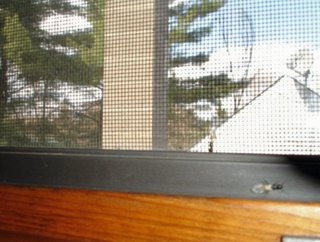 This does not make me happy. In fact, it makes me very unhappy. I went up to take a shower this afternoon (love being home and able to shower when I feel like it), and this is what I discovered on my bathroom window.
This does not make me happy. In fact, it makes me very unhappy. I went up to take a shower this afternoon (love being home and able to shower when I feel like it), and this is what I discovered on my bathroom window.A little peering underneath the window sill (which isn't nailed down for some reason) confirmed my suspicions that there were more. As dealing with flying insects isn't in MY job description, we've left them for the boy to handle when he gets home. I have a feeling after all these years we are going to have to have our house sprayed this year. That makes me sad. I have pesticide issues (and no I don't fertilize my lawn either) and the thought of poisoning my family and pets is very unsettling.
I googled, and came up with this lovely tid-bit.
Ants are social insects which live together in cooperative, intermingling colonies. The colonies may range in size from hundreds to millions of individuals, depending on the species. Within each colony are different types of individuals, each with a specific function. All ant colonies contain one or more queens, whose primary role is to lay eggs. The eggs hatch into white, grub-like larvae that later transform into adult "worker" ants. The workers feed and care for the queens and developing brood, and are the ones seen foraging for food and water, often at great distances from the colony. Ants lay down invisible odor trails, which the workers follow between food and the nest. In many species, the trail of ants is distinct enough to be followed back to the nesting location, or to where the ants are entering from outdoors.
At certain times of the year, ant colonies produce large numbers of winged individuals known as swarmers. These winged ants emerge from the nest to mate and establish new colonies. When a swarm of ants emerges inside a home, it's an indication that a nest is present within the structure. Fortunately, the success rate for swarmers establishing new colonies inside buildings is low. Nonetheless, an exodus of winged ants emerging indoors can be disturbing and often mistaken for termites.
The mistake most people make when attempting to control ants is only spraying the ones they see. This approach usually fails because the ants seen foraging over exposed surfaces is only a small portion of the colony. Typically, there will be thousands of additional ants including one or more egg-laying queens hidden somewhere in a nest. Eliminating queens and other colony members within nests is often the key to effective ant control.
I'm not exactly sure this makes me feel better or not..
1 comment:
Creepy bugs in the bathroom? Not my scene either. Too many legs. Centipedes really freak me out. Good luck with your de-infesting.
PS. Oh look, my code word today is "leags." Blogger is just playing with me now.
Post a Comment